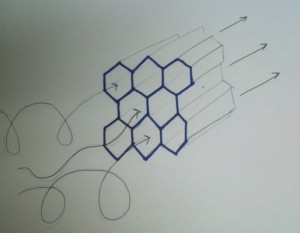Dear Fellow Basement Scientists,
Here we are, placing the last finishing touches on the entrance to the wind tunnel. This is pretty exciting! We are discussing today what is known at the honeycomb. I very briefly mentioned this part of the project in Wind Tunnel Design Overview, but now we will discuss its purpose and construction.
So, if you remember, the purpose of the bell mouth entrance is to reduce all the whirly-twirly turbulence coming into the test section. Reducing this turbulence increases the accuracy and consistency of lift and drag measurements. Well, believe it or not, despite all our valiant efforts on the bell mouth, there is still turbulence in the flow. Bummer! Well, no worries because we can simply install a honeycomb to help us out (as a note, there is always some turbulence in this flow, we are just reducing it as much as possible). A honeycomb consists of lots of little tubes. These tubes kill turbulence because there can’t be big swirls in a little tube. Here is a highly technical drawing laying out the details of this complicated phenomenon:
